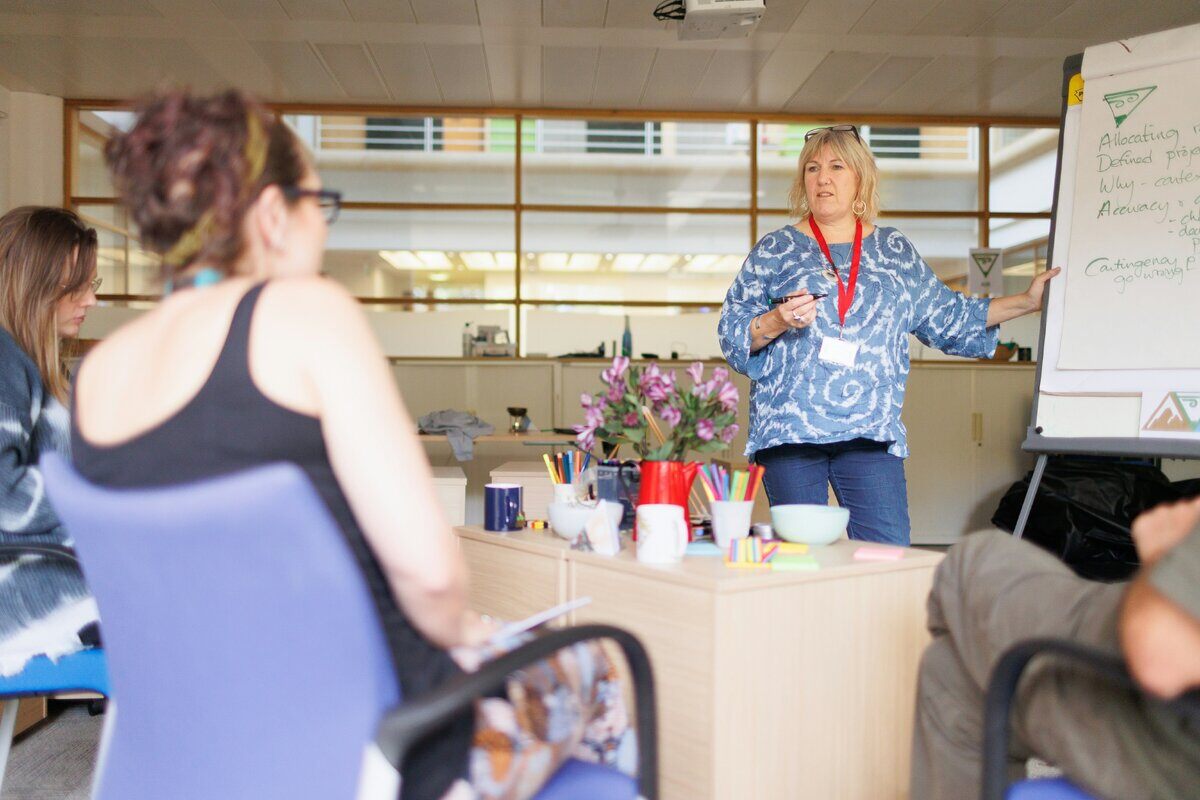
Using Blended Learning To Upskill and Reskill Your Workforce
Productivity is a delicate thing.
It requires effort and coordination.
It also requires teams to be in sync with the trends, culture, relevant tools, and prevailing wisdom of the times.
As you know, those are all things that are in constant flux.
This means your workforce has to adapt, change, retool, and reboot on a regular basis.
The problem is, keeping up with the pace of change is contrary to human nature.
People often want to stay in a niche, especially when it comes to work.
They want to do one thing well and stick with it.
It’s usually the exception and not the norm when an individual wants to relearn and readapt after they have completed the educational period of early adulthood.
Asking them to change, learn, and switch gears is a stressor.
The question is, will they lean into the challenge or shy away from it?
The answer to that question will depend on how we approach the task of workforce training.
The good news is that workforce training is an established tradition, and we have the tools to help you help your teams to keep pace with changing times.
In a modern context, those tools are blended learning, upskilling, and reskilling.
Workforce training is essential for the mere maintenance of a system of productivity.
For such a system to adapt and persist, we need to approach workforce training a little more seriously.
The Importance of Upskilling and Reskilling the Workforce
To understand the importance of these ideas, it may be helpful to think about the gaps in knowledge and culture between one generation and the next.
The best example might be the Baby Boom Generation and Generation X.
Today, Gen X is mature.
They have children of their own, and they’re even now sending their kids off to college
The Boomers fought in Vietnam, loved or loathed disco, and were shocked by the excesses of the 80s.
But the most defining difference between these two generations is their relationships to information technology.
The Boomers encountered info tech in middle adulthood.
Gen X started adapting to it in their teenage years.
We could go on for pages about the reasons why this separates these two generations.
But, we all know that Boomers are generally perceived to be averse to learning the ins and outs of info-tech.
Gen X, on the other hand, is like fish in water with computers and smartphones.
Gen X-ers are the go-to IT personnel of their families.
Boomers don't just implore their adult children to visit at Christmas, they beg them to come home and set up their Skype accounts.
Now, let's get back to what this means for a workforce in changing times.
The difference between the office workers of the 2000s and those of today would be as different as these two generations, and the gap would be just as wide without effective workforce training.
Of course, it's not all about adapting to new technology.
That's just an example of how rapidly the economy is changing.
These changes are driven by technology, but they affect all aspects of our culture because technology is the limiting factor in human communication.
More technology = more communication, and more communication = accelerated change.
To understand how to deal with the pace of change, we need to understand the terms upskill and reskill.
What Is Upskilling?
Upskilling means improving what you already have.
If you were a typist and you wanted to go from using a typewriter to a word processor, that would be upskilling.
Upskilling is usually easier for team members to accept—it’s less stressful and more agreeable.
This is true because upskilling a person is about making them stronger in skills they already have or teaching them similar but new skills.
It’s also about giving them more advanced tools to approach and accomplish tasks that they are already adept at.
If you wanted to train a UX designer to use new apps or if you wanted a merchandiser to attend a conference on retail, those are both examples of upskilling.
Most of the time, when a person is asked to upskill, they feel little to no resistance to it.
They understand you are asking them to become stronger in a skill set they already have.
While it may be a challenge to learn new skills, it tends to feel less threatening to a person's sense of job security.
What Is Reskilling?
Reskilling is similar but different.
It’s also a bit more challenging for the learner.
This is because reskilling is about learning new tools and new skills that are not related to a person's established mode of productivity.
For example, if you asked a public relations executive assistant to learn to use software development tools, that would be reskilling.
If you asked an automobile floor sales professional to become a light-duty mechanic, that would be another example.
What's important to understand about reskilling is that it can feel threatening to the person on the receiving end.
It’s very much like saying to them that what they do now is not enough.
The implication might be that if they don't learn the new skill or if they don't master the new task, they could be replaced by someone who has those skills and is familiar with those tasks.
So we want to emphasize the fact that for learning to be optimal, we need to put our personnel at ease.
We need to make sure they understand that we want them to grow in their current capacities.
It can be hard for a software engineer to understand why he should learn about electrical engineering.
But we need the abilities of our talent to grow.
We don't just want to swap them out for people with different skills.
We want to develop them into more capable professionals.
For the learning process to be effective, we believe it's important that it be about growth, not an ultimatum.
The Impact of COVID-19
Earlier, we talked about how significant the divide can be between two groups of people on opposite sides of a force of change.
We see it in the difference between the two generations.
Now, it will be helpful if we can see how current events happening in tandem with technological change can impose sweeping change that affects all people no matter who or where they are.
For this, we could hardly ask for a better example than the COVID-19 pandemic.
The pandemic triggered a massive shift in the ways we get things done in the professional world.
We lost large numbers of workers due to mandates, restrictions, and government handouts all at once.
At the same time, many of the people who stayed onboard switched from working on-site to working from home.
This has been both a good thing and a bad thing.
It has made it possible for workers to get to their desks without having to fight traffic.
But, the interposition of all that computing and network technology between the worker and the office has created a massive amount of difficulty in communications.
It has forced remote workers to have to become more tech-savvy than they were before.
Where an office worker might do all of her work using a web browser and a word processor, now she has to use these tools while using networking software at the same time.
Consider real estate agents as an example.
Where these professionals once did everything by phone and in person, they have to hold online conferences through apps like Zoom and Skype.
In many cases, they have to upskill by learning new apps and other tools
As this condition persists, real estate agents are having to learn to use apps that allow them to create new apps for specific use cases.
They are also having to learn to use remote presence and virtual technology.
This could be seen as reskilling, but in reality, it's both reskilling and upskilling.
A better example of reskilling in real estate might be the fact that they are having to replace team members they have lost due to the pandemic.
Many real estate agents have had to expand into corporate public relations, human resources, and other tasks previously excluded from their own specialized skill sets.
Even as the restrictions of the pandemic roll back, many people are now committed to established remote working systems.
To undo these systems and go back to the office would be a waste of the time and effort invested in setting them up.
Home offices would be moth-balled.
Corporate facilities would have to be reworked.
Whole motor pools would have to be leased.
So, to make the most of the changes we have had to adapt to, we reskill and upskill.
All of this has been done just to maintain productivity.
But blended learning, upskilling, and reskilling are also key to growing our operations.
This means we need to double down on these processes and reshape the way we do many things in the professional world.
Common Challenges to Upskilling and Reskilling Employees
In addition to people worrying about being replaced and expected to learn new tasks, there are other challenges we should be aware of.
They include:
- Lack of resources to help narrow the skills gap
- Lack of time for effective skills development
- Clear understanding of future skill needs in the workforce
Assuming a General Need for Learning
Not everyone needs to be reskilled or upskilled at the same time.
It's best to do training where it's needed and when.
A Lack of Personalization
Failure to customize learning to the person and to the task is another common problem.
People have specific learning strengths and weaknesses.
These also vary depending on their job type as well as their personality.
Lack of Workflow Fluidity
Learning tasks should merge with the flow of the workday as much as possible.
We should try to integrate learning to fit within the workday and integrate with the day's tasks.
Not Upskilling and Reskilling Proactively
When we wait too long to uptake new skills, it can be too late by the time we need those skills.
It's a bit like buying school supplies after our homework is already due.
Upskilling and Reskilling Your Workforce with Blended Learning
Fortunately, the advantages of blended learning are especially well suited to mitigating the challenges of upskilling and reskilling.
We can cater to learning styles with a host of digital tools and solutions.
We can time our training to be commensurate with changes to the culture or industry we work within.
Learning apps, video hosting services, online conferencing, and more can make these modes of learning easier.
They can also go a long way to show our workforces that we are interested in making them stronger, more skilled, and more valuable.
Conclusion
Blended learning is all about making upskilling more effective and making reskilling more practical.
It makes it easy for the workforce to onboard new information.
It also gives us a wonderful way to show our talent pools that we are still on their side as we ask them to improve.
Interested in learning more about how to upskill and reskill your workforce?
Sources & Additional Reading






